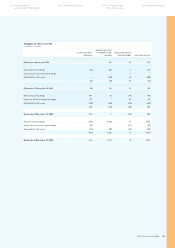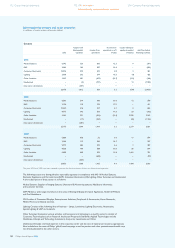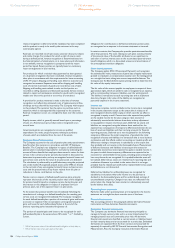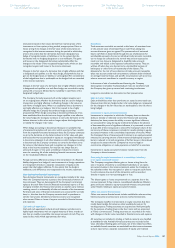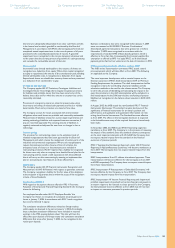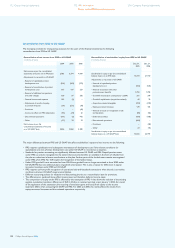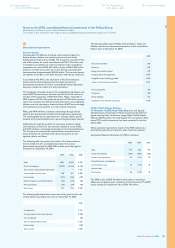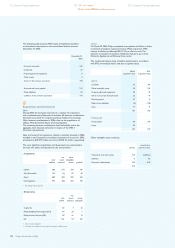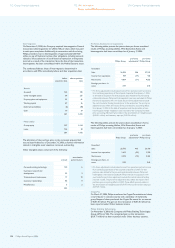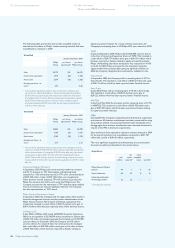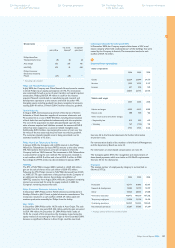Philips 2006 Annual Report Download - page 187
Download and view the complete annual report
Please find page 187 of the 2006 Philips annual report below. You can navigate through the pages in the report by either clicking on the pages listed below, or by using the keyword search tool below to find specific information within the annual report.
Philips Annual Report 2006 187
instruments based on fair values derived from market prices of the
instruments or from option pricing models, as appropriate. Gains or
losses arising from changes in the fair value of the instruments are
recognized in the income statement during the period in which they
arise to the extent that the derivatives have been designated as a
hedge of recognized assets or liabilities, or to the extent that the
derivatives have no hedging designation or are ineffective. The gains
and losses on the designated derivatives substantially offset the
changes in the values of the recognized hedged items, which are also
recognized as gains and losses in the income statement.
Changes in the fair value of a derivative that is highly effective and that
is designated and qualifi es as a fair value hedge, along with the loss or
gain on the hedged asset, or liability or unrecognized fi rm commitment
of the hedged item that is attributable to the hedged risk, are recorded
in the income statement.
Changes in the fair value of a derivative that is highly effective and that
is designated and qualifi es as a cash fl ow hedge, are recorded in equity,
until profi t or loss are affected by the variability in cash fl ows of the
designated hedged item.
The Company formally assesses, both at the hedge’s inception and
on an ongoing basis, whether the derivatives that are used in hedging
transactions are highly effective in offsetting changes in fair values or
cash fl ows of hedged items. When it is established that a derivative is
not highly effective as a hedge or that it has ceased to be a highly
effective hedge, the Company discontinues hedge accounting
prospectively. When hedge accounting is discontinued because it has
been established that the derivative no longer qualifi es as an effective
fair value hedge, the Company continues to carry the derivative on the
balance sheet at its fair value, and no longer adjusts the hedged asset
or liability for changes in fair value.
When hedge accounting is discontinued because it is probable that
a forecasted transaction will not occur within a period of two months
from the originally forecasted transaction date, the Company continues
to carry the derivative on the balance sheet at its fair value, and gains
and losses that were accumulated in equity are recognized immediately
in the income statement. In all other situations in which hedge accounting
is discontinued, the Company continues to carry the derivative at its
fair value on the balance sheet, and recognizes any changes in its fair
value in the income statement. For interest rate swaps that are
unwound, the gain or loss upon unwinding is released to income
over the remaining life of the underlying fi nancial instruments, based
on the recalculated effective yield.
Foreign currency differences arising on the retranslation of a fi nancial
liability designated as a hedge of a net investment in a foreign operations
are recognized directly in a separate component of equity, to the
extent that the hedge is effective. To the extent that the hedge is
ineffective, such differences are recognized in the income statement.
Non-derivative fi nancial instruments
Non-derivative fi nancial instruments are recognized initially at fair value
when the Company becomes a party to the contractual provisions of
the instrument. They are derecognized if the Company’s contractual
rights to the cash fl ows from the fi nancial instruments expire or if the
Company transfers the fi nancial instruments to another party without
retaining control or substantially all risks and rewards of the instruments.
Purchases and sales of fi nancial instruments are accounted for at trade
date, i.e., the date that the Company commits itself to purchase or
sell the instruments. Dividend and interest income are recognized
when earned. Gains or losses, if any, are recorded in fi nancial income
and expenses.
Cash and cash equivalents
Cash and cash equivalents include all cash balances and short-term
highly liquid investments with an original maturity of three months or
less that are readily convertible into known amounts of cash. They are
stated at face value which approximates fair value.
Receivables
Trade accounts receivable are carried at the lower of amortized cost
or the present value of estimated future cash fl ows, taking into
account discounts given or agreed. The present value of estimated
future cash fl ows is determined through the use of allowances for
uncollectible amounts. As soon as individual trade accounts receivable
can no longer be collected in the normal way and are expected to
result in a loss, they are designated as doubtful trade accounts
receivable and valued at the expected collectible amounts. They are
written off when they are deemed to be uncollectible because of
bankruptcy or other forms of receivership of the debtors. The
allowance
for the risk of non-collection of trade accounts receivable
takes into account credit-risk concentration, collective debt risk based
on average historical losses, and specifi c circumstances such as serious
adverse economic conditions in a specifi c country or region.
In the event of sale of receivables and factoring, the Company
derecognizes receivables if substantially all risks are transferred and
the Company has given up control and continuing involvement.
Long-term receivables are discounted to their present value.
Debt and other liabilities
Debt and liabilities other than provisions are stated at amortized cost.
However, loans that are hedged under a fair value hedge are remeasured
for the changes in the fair value that are attributable to the risk that is
being hedged.
Investments in equity-accounted investees
Investments in companies in which the Company does not have the
ability to directly or indirectly control the fi nancial and operating
decisions, but does possess the ability to exert signifi cant infl uence,
are accounted for using the equity method. Generally, in the absence
of demonstrable proof of signifi cant infl uence, it is presumed to exist if
at least 20% of the voting stock is owned. The Company’s share of the
net income of these companies is included in results relating to equity-
accounted investees in the consolidated statements of income. When
the Company’s share of losses exceeds its interest in an equity-accounted
investee, the carrying amount of that interest (including any long-term
loans) is reduced to nil and recognition of further losses is discontinued
except to the extent that the Company has incurred legal or
constructive obligations or made payments on behalf of an associate.
Investments in equity-accounted investees include loans from the
Company to these investees.
Accounting for capital transactions of a consolidated subsidiary
or an equity-accounted investee
The Company recognizes dilution gains or losses arising from the
sale or issuance of stock by a consolidated subsidiary or an equity-
accounted investee in the income statement, unless the Company or
the subsidiary either has reacquired or plans to reacquire such shares.
In such instances, the result of the transaction will be recorded
directly in equity as a non-operating gain or loss.
The dilution gains or losses are presented on a separate line in the
income statement if they relate to consolidated subsidiaries. Dilution
gains and losses related to equity-accounted investees are presented
under Results relating to equity-accounted investees.
Other non-current fi nancial assets
Other non-current fi nancial assets include available-for-sale securities,
held-to-maturity securities, loans and cost-method investments.
The Company classifi es its investments in equity securities that have
readily determinable fair values as either available-for-sale or for
trading purposes. Trading securities are acquired and held principally
for the purpose of selling them in the short term and are presented
as ‘Other current assets’. Trading securities are recorded at fair value
with changes in the fair value recorded in fi nancial income and expense.
All securities not included in trading or held-to-maturity are classifi ed
as available-for-sale. Available-for-sale securities are recorded at fair
value. Unrealized holding gains and losses, net of the related tax effect,
on available-for-sale securities are excluded from the income statement
and are reported as a separate component of equity until realized.
226 Corporate governance224 Reconciliation of
non-US GAAP information
234 The Philips Group
in the last ten years
236 Investor information






